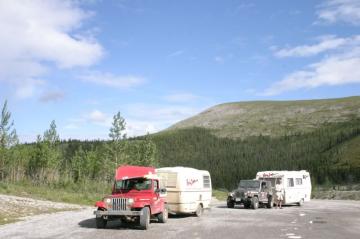Stone Mountain Provincial Park & Summit Lake

Park Size: 25, 691 hectare
Difficulty: Easy - Family
Park Amenities:
Stone Mountain Provincial Park
Stone Mountain Provincial Park is located east of the community of Watson Lake, Yukon Territory on the British Columbia side of the Alaska Highway. The park is near the community of Fort Nelson in British Columbia east of Toad River.
 The 25, 691 hectare Stone Mountain Provincial Park encompasses a large portion of the Northern Rocky Mountains. The park is home to alpine valleys, flowering meadows, mountain peaks, raging rivers, remote lakes and many species of wildlife.
The 25, 691 hectare Stone Mountain Provincial Park encompasses a large portion of the Northern Rocky Mountains. The park is home to alpine valleys, flowering meadows, mountain peaks, raging rivers, remote lakes and many species of wildlife.
The most visited destination in the park is Summit Lake. The lake is a popular stop for travelers who are exploring the Alaska Highway as there is a campground, boat launch, pit toilets, picnic tables and many hiking trails. It is from Summit Lake that many begin multi day adventures horseback riding or backpacking.
The Stone Mountain Provincial Park and Summit Lake attract many activities to the region. Some of the other activities enjoyed in the region include hiking, sightseeing, fishing, rving, wildlife watching, birdwatching, picnicking, wilderness camping and canoeing.
In the alpine mountains the weather changes quickly. It is important to be smart and prepare for all types of weather conditions. Always have weather gear handy for big winds and rain. Dress in layers. And never begin an activity without a good water supply and good equipment.
There are both easy and difficult hiking trails in the Stone Mountain Provincial Park. The trails range from challenging day hikes to multi day backpacking adventures exploring the wilderness backcountry. Most of the hiking trails begin near the Summit Lake Campground.
The Summit Peak Trail begins opposite the campground on the other side of the Alaska Highway. There is a pull out parking area and interpretive signs marking the trailhead. The Summit Peak Trail measures 5 kilometres round trip. It is an elevation hike leading to alpine views of the valley.
The Erosion Pillars Trail is one of the easier trails in the area. It is a short 500 metre hike to a viewpoint with views of hoodoos.
The Flower Springs Trail is a 6 kilometre round trip hike leading to some waterfalls and alpine lakes. From the Flower Springs Trail experienced backpackers can venture deeper into what is now called the Northern Rocky Mountain Park where there are some wilderness camping sites. Only experienced backpackers should attempt to venture into the unmaintained portion of the park.
MacDonald Creek Valley Trail is a horseback riding and backpacking trail measuring 32 kilometres with plenty of opportunities to enjoy some wilderness backcountry camping opportunities. Extend the adventure further by exploring the WokkPash Valley and the adventure becomes a loop route measuring 71 kilometres.
The Wokkpash Valley - MacDonald Creek Loop Trail is a 5 to 8 day adventure. Most begin at the trailhead located on the Old Churchhill Mine Road. From the Alaska Highway the trailhead is 17 kilometres down the road. The trail visits Wokkpash Gorge, Forlorn creek, Wokkpash lake, Plug Creek, Whitestone Ridge, Last Call Lake to the trailhead exit at Babba Canyon on the Alaska Highway.
Whether driving the Alaska Highway or hiking a trail or camping in the campground... there are plenty of opportunities to view wildlife. Some of the wildlife in the park includes marmots, moose, grizzlies, black bears, wolves, beavers, caribou, stone sheep and mountain goats.
Address:



